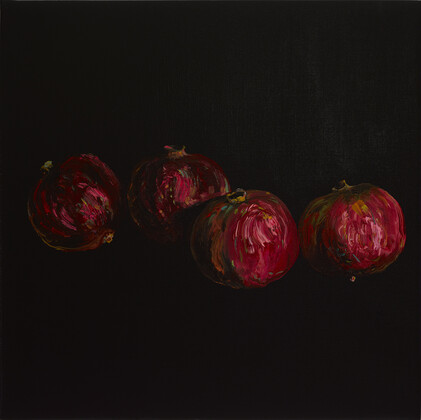ZENG FANZHI 曾梵志
b. 1964, works and lives in Beijing

Introduction
In the beginning of his artistic career in the late 80's, Zeng Fanzhi painted apocalyptic, expressionist images, thus manipulating modernist compositional effects to intensify his sinister version of reality. His representational work reveals the place of the unconscious and aberrant in the construction of experience. The over-sized, clenched hands of his subjects are almost more remarkable than their stereotyped faces and wide-open eyes. Zeng Fanzhi's art simulates the fatigue of the contemporary experience: the rush to acquire and consume to the point of alienation and detachment. Working in idiosyncratic ways, he reminds us how effective art can be when it collapses these various experiences. He traces the eruption of the corporeal into the optical sedition of visual art.Zeng Fanzhi's notorious mask series conducted in the mid 90's marks a turn in his aesthetics. All the figures in the series wear white masks fused closely with the facial features. The masks nevertheless possess a peculiar, haunting power. His figures look anxious or fearful, as if they are victims of their own roles. Through the mask motif, Zeng Fanzhi expresses suspended reality. The mood of his work is subtle unsettlement: it often suggests some past violence, recent or old, from which we can unravel clues - but never completely understand. His paintings are much more than sardonically recycled imagery. Zeng Fanzhi delivers an art that feels new, not in its premises but in its refined vitality. His late paintings signify a shift in his focus from a formal concern with the representation of existential unsettlement to an interest in how we imagine ourselves interacting with nature. Still, in his newly developed landscape paintings, there is a notion of permanent escape - an attempt to inhabit the uninhabitable. These images are expressively abstract. Rendered in cool shades of pink, black and blue, they represent the tension of failed community and human loneliness. Within these large-scale images there is a notion of fragility and vulnerability; like an attempt to create a terrain of uncertainty that inhabits both characters and landscape depicted. The grand scale of the paintings lends them a certain suggestive and sublime appearance. When viewed, the paintings constantly seem to evolve and create new particular impressions. The images reflect a social reality that is made up of multiple signifying systems of which the landscape is just one.
Zeng Fanzhi was born in 1964 in Wuhan province and studied oil painting at the Wuhan Art Academy. Today he lives and works in Beijing. Recent solo exhibitions include: Zeng Fanzhi: Near and Far/Now and Then, Scuola Grande della Misericordia in Venice, Italy (2024); Zeng Fanzhi Catalogue Raisonne, 1984-2004-Book Launch, Seminar & Exhibition, Yiyuan Space, Wuhan (2020); Collection Exhibition: Zeng Fanzhi Solo Exhibition, Los Angeles County Museum of Art, Los Angeles, U.S.A. (2019); Zeng Fanzhi. In the Studio, Hauser & Wirth, Hong Kong, London, Zürich (2018); Zeng Fanzhi | Van Gogh, Van Gogh Museum, the Netherlands, Amsterdam (2017); Zeng Fanzhi Solo Exhibition: Parcours, UCCA, Beijing (2016); Zeng Fanzhi: The Louvre Project, ShanghART Beijing, Beijing (2015); Zeng Fanzhi, Louvre Museum, Paris, France (2014); Zeng Fanzhi Solo Exhibition, Musee d'Art Moderne de la Ville de Paris, Paris, France (2013); Zeng Fanzhi Solo Exhibition, Gagosian Gallery, London, U.K. (2012); 2010 Zeng Fanzhi Solo Exhibition, Rockbund Art Museum, Shanghai(2010); Zeng Fanzhi Solo Exhibition, Acquavella Gallery, New York, U.S.A. (2009); Narcissus Looks for Echo, Zeng Fanzhi Solo Exhibition, Suzhou Museum, Jiangsu (2009); Zeng Fanzhi Solo Exhibition: Tai Ping You Xiang, ShanghART Beijing, Beijing (2008); Zeng Fanzhi Solo Exhibition: Idealism, Singapore Art Museum (SAM), Singapore (2007) etc.

